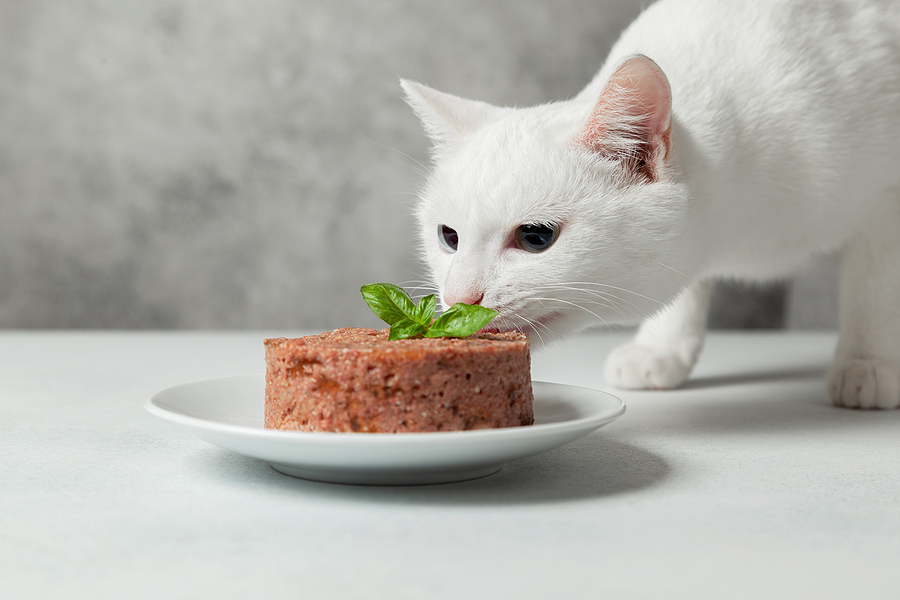Buckle up. The answer to the question, “Can Cats Be Vegan?” is long, detailed, and scientific.
“Should Cats Be Vegan?” is an entirely different question and is likely to create a passionate debate based on personal opinion. Let’s suspend our personal opinions and focus on science.
Omnivore Versus Obligate Carnivore Explained
Nature is efficient. To survive, an animal needs to spend as little energy as possible obtaining and digesting food. For the most part, animals instinctively choose the available food that is most likely to sustain life. For example, humans are omnivores. We evolved to be both hunters and gatherers, and to eat a variety of foods. Our bodies can use the nutrients from plant or animal sources to assemble the essential nutritional components we need to live.
Cats are different. Cats’ bodies cannot build some required nutrients from the components found in a variety of foods to meet their nutritional needs, the way human bodies can. To stay alive, cats require the finished products of many nutrients found only in the meat of other animals.
Cats evolved as hunters that consume only their prey, such as mice and birds. The bodies of these animals are high in protein, moderate in fat, and very, very low in carbohydrates. Nutritionally, a cat’s daily energy intake in nature is about 52 percent protein, 46 percent fat, and only 2 percent carbohydrates, sugars, and starches, often found in the gastrointestinal contents of their prey. Cats need to get more than a dozen vitamins, minerals, fatty acids, and amino acids directly from their food. Taurine, arginine, histidine, isoleucine, leucine, lysine, methionine, phenylalanine, threonine, tryptophan and valine must come from the meat they eat.
As an example, let’s talk about the amino acid taurine. As omnivores, humans can make taurine in a process called biosynthesis. The biosynthesis of taurine involves oxidation of the thiol group of the cysteine, which is followed by a decarboxylation reaction (a chemical reaction that removes a carboxyl group and releases carbon dioxide) and a final spontaneous reaction to form taurine. As obligate carnivores, cats’ bodies are unable to do this. Cats require taurine in its final form, found in the meat of other animals.
When cats do not get enough taurine, their heart muscle becomes thin and weak. As it degrades, the heart is not strong enough to pump blood and supply oxygen to the body. This disease is called dilated cardiomyopathy and it is fatal. Likewise, the consequences for an obligate carnivore of missing the dozens of vitamins, minerals, fatty acids, and amino acids found in meat are dire.
Nutrients Versus Ingredients
Ingredients are the components that make a food. In the case of cat food, these can include meat, meat by-products (such as organ meat), beef tallow, meat, fish or bone meal, brewers rice, corn gluten meal, and vitamins, minerals, and preservatives.
Nutrients are carbohydrates, proteins, fats, vitamins, minerals, fiber, and water. A nutrient, such as protein, can come from many different ingredients: meat, meat by-products, or meal. Protein can also come from plants such as soy, pea, rice, lentils, chickpeas, and fungi. Sounds good, right? Well, it gets more complicated than that.
Plant proteins differ from animal proteins in amino acid content and digestibility. Plant proteins are often incomplete, meaning they do not contain all of the amino acids that animal protein contains. And simply because a nutrient exists as an ingredient does not necessarily mean your cat’s body can use it. Bioavailability is the term for the portion of a substance that enters the body and is able to have an active effect. The bioavailability of amino acids such as taurine in plant protein varies based on fiber content and the effects of bacteria, which can break down taurine in plant protein.
Taurine is not the only problematic nutrient for cats fed a vegan diet. Vitamin D, arachidonic acid, niacin, cobalamin, and retinol sourced from animals are more bioavailable than plant-based sources. To make matters even more precarious, recent studies show that the nutrients listed on the bags of vegan cat foods are not consistent with what is actually in the bag.
Can cats be vegan? The science behind plant-based protein as the exclusive source of protein in a cat’s diet is new. And, as you can see, it is very complicated. Getting it wrong could cost cats all nine lives.
This article was reviewed/edited by board-certified veterinary behaviorist Dr. Kenneth Martin and/or veterinary technician specialist in behavior Debbie Martin, LVT.








